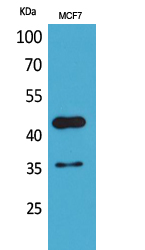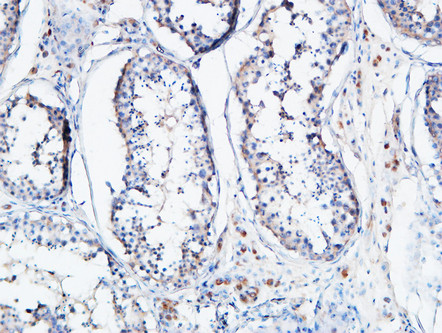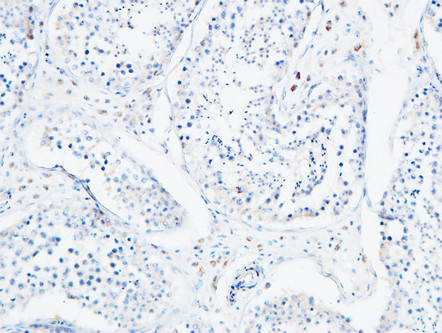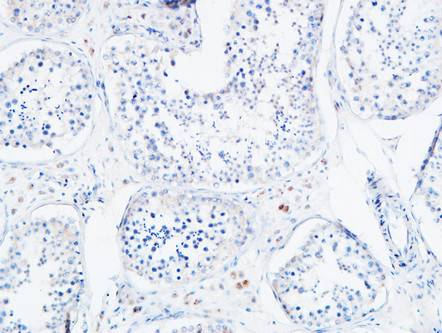产品名称
Angptl4 Rabbit Polyclonal Antibody
别名
ANGPTL4; ARP4; HFARP; PGAR; PP1158; PSEC0166; Angiopoietin-related protein 4; Angiopoietin-like protein 4; Hepatic fibrinogen/angiopoietin-related protein; HFARP
蛋白名称
Angiopoietin-related protein 4
存储缓冲液
Liquid in PBS containing 50% glycerol, 0.5% BSA and 0.02% New type preservative N.
Human Gene Link
http://www.ncbi.nlm.nih.gov/sites/entrez?db=gene&term=51129
Human Swissprot No.
Q9BY76
Human Swissprot Link
http://www.uniprot.org/uniprotkb/Q9BY76/entry
Mouse Gene Link
http://www.ncbi.nlm.nih.gov/sites/entrez?db=gene&term=57875
Mouse Swissprot No.
Q9Z1P8
Mouse Swissprot Link
http://www.uniprot.org/uniprot/Q9Z1P8
Rat Gene Link
http://www.ncbi.nlm.nih.gov/sites/entrez?db=gene&term=362850
Rat Swissprot Link
http://www.uniprot.org/uniprot/Q6TMA8
免疫原
The antiserum was produced against synthesized peptide derived from the Internal region of human ANGPTL4. AA range:301-350
特异性
Angptl4 Polyclonal Antibody detects endogenous levels of Angptl4 protein.
稀释度
IHC-p: 100-300.WB 1:500 - 1:2000. ELISA: 1:20000.. IF 1:50-200
宿主
Polyclonal, Rabbit,IgG
背景介绍
This gene encodes a glycosylated, secreted protein containing a C-terminal fibrinogen domain. The encoded protein is induced by peroxisome proliferation activators and functions as a serum hormone that regulates glucose homeostasis, lipid metabolism, and insulin sensitivity. This protein can also act as an apoptosis survival factor for vascular endothelial cells and can prevent metastasis by inhibiting vascular growth and tumor cell invasion. The C-terminal domain may be proteolytically-cleaved from the full-length secreted protein. Decreased expression of this gene has been associated with type 2 diabetes. Alternative splicing results in multiple transcript variants. This gene was previously referred to as ANGPTL2 but has been renamed ANGPTL4. [provided by RefSeq, Sep 2013],
组织表达
Detected in blood plasma (at protein level) (PubMed:29899519). Detected in liver (PubMed:10698685). Detected in white fat tissue and placenta (PubMed:10866690). Expressed at high levels in the placenta, heart, liver, muscle, pancreas and lung but expressed poorly in the brain and kidney.
细胞定位
Secreted . Secreted, extracellular space, extracellular matrix . The unprocessed form interacts with the extracellular matrix (PubMed:17068295, PubMed:21398697). This may constitute a dynamic reservoir, a regulatory mechanism of the bioavailability of ANGPTL4 (Probable). .
功能
caution:The sequence shown here is derived from an Ensembl automatic analysis pipeline and should be considered as preliminary data.,disease:Found to be highly expressed in the early stages of collagen-induced arthritis (CIA).,disease:Produced in ischemic tissues in conditions such as critical leg ischemia. In tumors, ANGPTL4 could be produced in the hypoxic areas surrounding necrotic regions. High levels could be produced in tumor cells of conventional renal cell carcinoma. This molecule therefore seems to be a marker of conventional renal cell carcinoma.,disease:Serum levels of ANGPTL4 are significantly lower in patients with diabetes type 2 than those in healthy subjects, suggesting that decreased ANGPTL4 could be a causative factor of this disease.,function:Protein with hypoxia-induced expression in endothelial cells. May act as a regulator of angiogenesis and modulate tumorgenesis. Inhibits proliferation, migration, and tubule formation of endothelial cells and reduces vascular leakage. May exert a protective function on endothelial cells through an endocrine action. It is directly involved in regulating glucose homeostasis, lipid metabolism, and insulin sensitivity. In response to hypoxia, the unprocessed form of the protein accumulates in the subendothelial extracellular matrix (ECM). The matrix-associated and immobilized unprocessed form limits the formation of actin stress fibers and focal contacts in the adhering endothelial cells and inhibits their adhesion. It also decreases motility of endothelial cells and inhibits the sprouting and tube formation.,PTM:N-glycosylated.,similarity:Contains 1 fibrinogen C-terminal domain.,subcellular location:The unprocessed form interacts with the extracellular matrix. This may constitute a dynamic reservoir, a regulatory mechanism of the bioavailability of ANGPTL4.,subunit:Homooligomer. The homooligomer undergoes proteolytic processing to release its carboxyl fibrinogen-like domain, which circulates as a monomer. The homooligomer unprocessed form is able to interact with the extracellular matrix.,tissue specificity:Expressed at high levels in the placenta, heart, liver, muscle, pancreas and lung but expressed poorly in the brain and kidney.,
纯化
The antibody was affinity-purified from rabbit antiserum by affinity-chromatography using epitope-specific immunogen.





